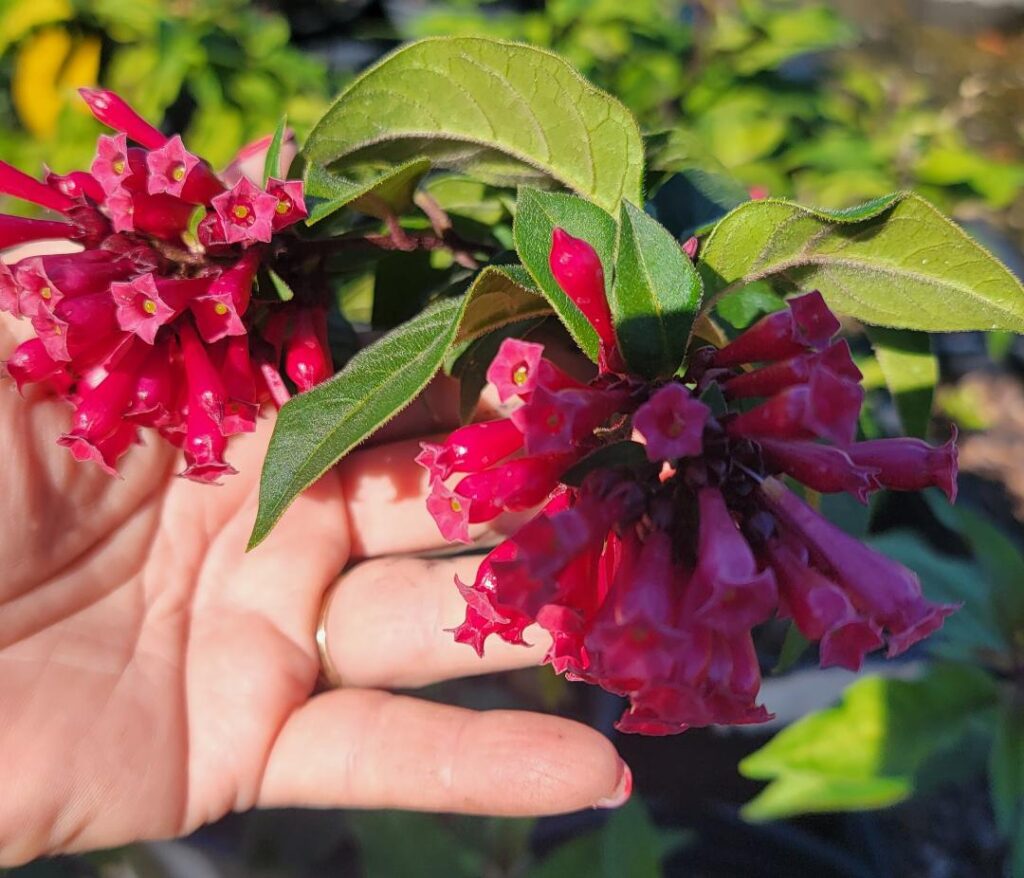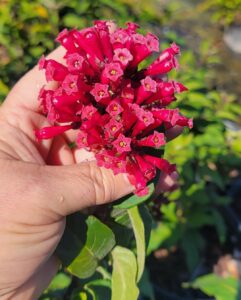S & J Nursery’s Guide to Growing
Red Cestrum / Newells Cestrum
in the Northeast Florida Landscape
( Cestrum fasciculatum var. newelii )

Red Cestrum newelii Origins:
– Native to Mexico, Central and South America and the West Indies, Red Cestrum is a shrubby semi-evergreen plant that is cold hardy to 15-20 degrees. They can be planted in zones 8-11, but you can expect some damage to foliage and flowers when temperatures are in the low 30s so cover them or let them go and trim off damaged stems for quick recovery in the spring when all danger of frost has passed.
– Although these plants are hard to come by, they are worth the wait to add
them to your landscape. I stock them every time I can find them here at S & J Nursery! Cultivated for their soft pink blooms and easy maintenance plant habit. Red cestrum blooms sporadically in late spring, summer and fall.
Sun Exposure for the Red Cestrum newelii:
– Red Cestrum newelii plants are best planted in areas that will
receive full or partial sun. In Northeast Florida, a plant receiving 6 hours or more of sun exposure is considered to be planted in a full sun location. Morning shade and afternoon sun is ideal, or filtered light under taller growing shade trees. Plants will bloom less in lower light areas but may be better protected from damaging winter frosts in those same shadier locations.
– Best if planted on the south side of the house away from cold north winds,
up next to a fence or near the foundation of a home or other building, or near larger shade trees that will protect these tropical plants from frost. Or plant on the west side of a home or building.
Foliage of the Red Cestrum newelii Plant:
– Medium to deep olive green semi evergreen foliage depending on winter temperatures) in zone 8-11. Foliage may remain evergreen or may go dormant in our Northeast Florida area gardens. But will quickly regrow from its roots or stems the following spring in the Jacksonville and St. Augustine area gardens.
– As with all tropical plantings, they are particularly responsive to their
individual planting location. When planted on the south side of the house away from north winds, or where receiving some frost protection from larger trees or nearby buildings. Utilize your yards frost free microclimates for all of your tropical plant selections.
– Like all members of the Tomato ( nightshade) family the leaves, flowers and berries all contain toxins, so plant at the back of the border and out of the way of curious creatures.
Soil Preference / Salt tolerance of the Red Cestrum newelii:
– Red Cestrum plants are at home in our Northeast Florida’s sandy soils but will still benefit from soil amendment at planting time. Amend the soil when planting with compost to help your Jacksonville and St. Augustine area soil hold both water and nutrients and keep your cestrum plants healthy and blooming.
– Salt tolerance unknown
Size Variance of Red Cestrum newelii Plants:
– The foliage on the Red Cestrum newelii plant can reach heights of 6-8 ft ft in height and 4-6 ft in width . Touted to be fast growing, I have not found that to be the case and get about 6 inches of growth each year here in our Northeast Florida landscape. maybe I dont give them enough love, they are so easy care I tend to leave them alone and let them be most of the time and am able to easily keep mine in the 3-4 ft high and wide size range with annual pruning.
Growth Habit of the Red Cestrum newelii Plants:
– Upright foliage will produce long sprawling stems if not trimmed.
– Responds well to pruning, so don’t be afraid to cut them back and keep them nice and tidy!
Growth Rate of the Pink Cestrum / Cestrum elegans Smithii Plant:
– Fast growing particularly during the hot summer months!

Blooms of the Red Cestrum newelii:
– Blooms on an off a few times each year during summer and fall, blooms are followed by reddish purple inedible berries in fall and winter.
– One inch long tubular blooms in semi cascading clusters, blooms of the Red Cestrum newelii are a beautiful and vibrant rose red color that is an absolute standout in the garden.
Water Requirements of the Red Cestrum newelii :
– Although much more durable once established in the landscape, regular water is necessary to get the plant rooted and growing on its own after being planted in the ground from an S & J Nursery container.
– Fully rooted and established cestrum plants are moderately drought tolerant and should only need supplemental irrigation in times of drought.
Best Uses For Red Cestrum in the Jacksonville | St. Augustine Area
Landscapes :
– Cestrum plants can be used in foundation plantings, as an accent near entry ways patio areas, or as a beautiful container potted plant.
– Easy care landscape plant, with the minimum of a once a year trimming needed to shape.
– Makes an excellent hedge screen when planted along side of wooden fences, etc. Great back o fthe border plant for hummingbirds and butterflies.
Care of Red Cestrum in the Northeast Florida
Landscape:
– Amend sandy soils generously with compost to help your Red Cestrum Smithii plants get the much needed water and nutrients it takes to feed these heavy blooming beauties.
– Water every day during the establishment period after planting in the garden from an S & J Nursery container. Be sure to continue supplemental irrigation during the hot summer months during prolonged droughts.
– Fertilize each year just after trimming in the spring with a good shovel full
of garden compost or use Osmocote or another slow release plant food spring, summer and fall.
– When temperatures drop into the 25-30 degrees you may opt to protect your foliage and stems from severe frost damage by throwing a blanket or other breathable fabric over the top of the plant making sure the edges touch the ground to trap in the heat from the soil.
– Make your last summer pruning in August giving your Red Cestrum Newlii plant ample time to recover new foliage that will harden off before winter arrives for us here in late December. Pruning too late into the fall will cause flushes of cold sensitive new growth that is sure to freeze during even a light frost that hardened off foliage would not be affected by.
– DO NOT REMOVE WINTER BURNT FOLIAGE UNTIL ALL DANGER OF FROST HAS PASSED. Be sure not to remove any stems or leaves from the plant until we have reached the last average frost date and there are no late freezes being predicted. ( mid February for Northeast Florida is the average last frost date) Trimming burnt foliage and stems before then will leave bare branches deeper on the plant exposed to cold temperatures that would have been protected by those same stems and foliage if left unpruned and most often results in loss of the plant entirely.

